Q: What type of nucleic acid is single-stranded and contains the bases Guanine, Cytosine, Adenine, and Uracil, and the sugar ribose?
A: RNA
Q: What is the role of DNA in controlling the cell and how is it structured?
A: DNA’s role is to store genetic information and control cellular functions, and it is structured as a double helix.
Q: In eukaryotic cells, where does DNA replication take place, and when does it occur in the cell cycle?
A: DNA replication takes place in the nucleus during the interphase (specifically the S phase) of the cell cycle.
Q: Which type of nucleic acid has the sugar deoxyribose and the base Thymine?
A: DNA
Q: What are the roles of helicase, primase, DNA polymerase, and ligase during DNA replication?
A: Helicase unwinds the double helix by breaking hydrogen bonds, primase creates an RNA primer, DNA polymerase replicates the DNA molecules to build a new strand, and ligase connects DNA fragments together.
Q: Which type of RNA travels out of the nucleus to a ribosome in eukaryotic cells?
A: Messenger RNA (mRNA)
Q: What are the three main types of RNA and their roles in transcription and translation?
A: Messenger RNA (mRNA) is involved in transcription, transfer RNA (tRNA) and ribosomal RNA (rRNA) are involved in translation.
Q: Where does transcription take place and what is its end result and purpose?
A: Transcription takes place in the nucleus and its end result and purpose is to create an mRNA molecule.
Q: What is the role of single-stranded binding proteins (SSB) during DNA replication?
A: The role of SSB proteins is to bind to the separated DNA strands, stabilizing them and preventing them from rejoining.
Q: Is DNA directly involved in transcription, and which type of RNA is involved in this process?
A: Yes, DNA is directly involved in transcription, and messenger RNA (mRNA) is the type of RNA involved.
Q: Are the two strands that make up DNA identical or complementary?
A: The two strands that make up DNA are complementary, not identical.
Q: What does it mean for DNA strands to be anti-parallel?
A: Anti-parallel means that the two strands of DNA run in opposite directions, with one strand running 5′ to 3′ and the other running 3′ to 5′.
Q: In which direction does the leading strand synthesize during DNA replication, and what about the lagging strand?
A: The leading strand is synthesized in the 5′ to 3′ direction, while the lagging strand is synthesized in the 3′ to 5′ direction.
Q: Where does translation take place, and what are the end result and purpose of this process?
A: Translation takes place at the ribosome, and its end result and purpose are to create a chain of amino acids, which forms a large protein.
Q: What are the fragments of DNA called on the lagging strand during replication?
A: The fragments of DNA on the lagging strand are called Okazaki fragments.
Q: Why do primers need to be replaced on the lagging strand during DNA replication?
A: Primers need to be replaced on the lagging strand because they are made of RNA, which needs to be removed and replaced with DNA.
Q: What does ligase do for the Okazaki fragments during DNA replication?
A: Ligase helps to join the Okazaki fragments by sealing the gaps between them, creating a continuous DNA strand.
Q: Is DNA directly involved in translation?
A: No, DNA is not directly involved in translation, as it remains in the nucleus and translation occurs at the ribosome.
Q: Which types of RNA are involved in translation?
A: Messenger RNA (mRNA) and transfer RNA (tRNA) are the types of RNA involved in translation.
Q: What does it mean for DNA replication to be semiconservative?
A: Semiconservative replication means that each new DNA molecule consists of one original strand and one newly synthesized strand,
preserving the original genetic information.
Q: What is the special ability of DNA polymerase during DNA replication?
A: DNA polymerase has a proofreading ability that allows it to correct errors during replication, resulting in very few mistakes.
1) I am a nucleic acid.
- DNA
- RNA
- both
2) I am usually single-stranded
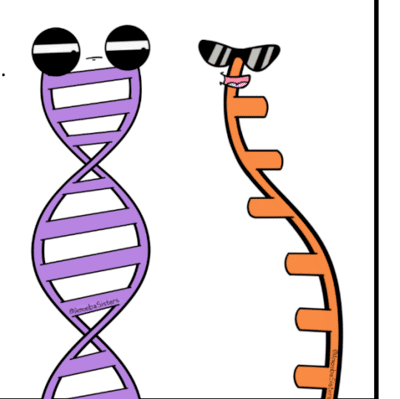
- DNA
- RNA
- both
3) I am generally found both inside and outside of the nucleus [in eukaryotic cells].
- DNA
- RNA
- both
4) I am arranged as a double helix, and my shape is often described as a “twisted ladder.”
- DNA
- RNA
- both
5) I include bases guanine, cytosine, and adenine.
- DNA
- RNA
- both
6) I include the base uracil.
- DNA
- RNA
- both
7) I include the base thymine.
- DNA
- RNA
- both
8) I generally remain in the nucleus [in eukaryotic cells].
- DNA
- RNA
- both
9) I have the sugar deoxyribose.
- DNA
- RNA
- both
10) I am made up of nucleotides.
- DNA
- RNA
- both
11) I have the sugar ribose.
- DNA
- RNA
- both
12) What does mRNA stand for?
- Transfer RNA
- Ribosomal RNA
- Messenger RNA
13) What does tRNA stand for?
- Transfer RNA
- Ribosomal RNA
- Messenger RNA
14) What does rRNA stand for?
- Deoxyribose RNA
- Ribosomal RNA
- Messenger RNA
15) I am generally found both inside and outside of the nucleus
- DNA
- RNA
- both
16) Transcription takes place here (in a eukaryotic cell)
- Mitochondria
- Vacuole
- Nucleus
17) Is DNA directly involved in the process of transcription?
- yes
- no
18) Where does translation take place?
- Vacuole
- Mitochondria
- Ribosomes
19) Which type(s) of RNA are involved in translation?
- Ribosomal RNA (rRNA)
- Messenger RNA (mRNA)
- Transfer RNA (tRNA)
- all RNA listed
20) Which process is shown?
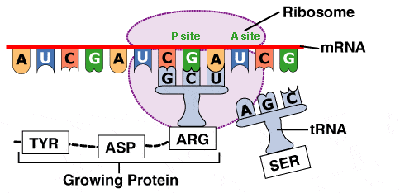
- mitosis
- transcription
- translation
21) What is occurring in this picture?
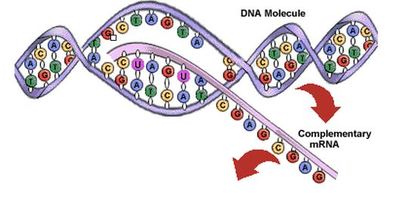
- DNA Replication
- Mitosis
- Transcription
22) Which of these bases does not exist in RNA?
- T
- C
- A
- U
23) What does tRNA do?
- make up ribosomes
- help with RNA splicing
- carry amino acids to ribosomes
24) Which type of RNA contains the codons and is translated into proteins?
- rRNA
- tRNA
- mRNA
25) What does rRNA do?
- carry amino acids to ribosomes
- help with RNA splicing
- make up ribosomes
- carry info from genes to ribosomes
26) What image is this?
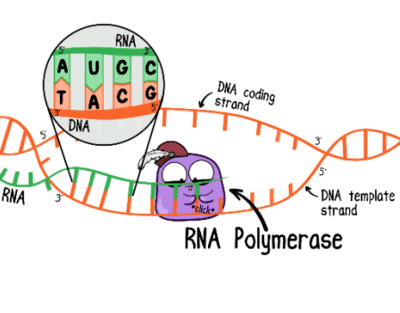
- transcription
- translation
27) what image is this?
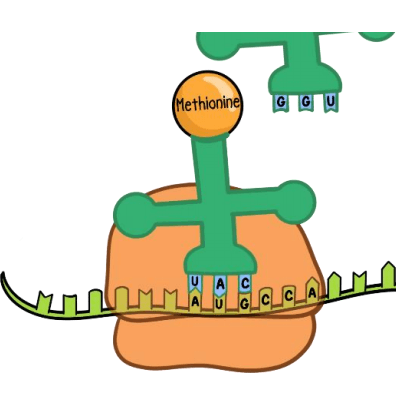
- translation
- transcription
28) Adenine bonds with ______________.
- Adenine
- Cytosine
- Thymine
29) Guanine bonds with ______________.
- Thymine
- Cytosine
- Adenine
30) What are the 4 nitrogen bases? (DNA)
- adenine, thymine, cytosine, and glucose
- adenine, thymine cytosine, and guanine
- adenine, thymine, cytoplasm, and guanine



